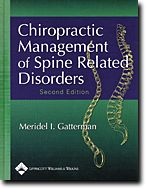|
|
Chiropractic Management of Spine Related Disorders, 2nd Edition
Book Review
by
Scott Hopkins, DC
| Title: |
Chiropractic Management of Spine Related Disorders, 2nd Edition |
| Author: |
Meridel I. Gatterman, MA, DC, MEd
|
| Publisher: |
Lippincott Williams & Wilkins, 2004
|
| Part #: |
T-259 |
 No matter how hard you studied in school or how well you did on boards, it is inevitable that you're going to forget some of the stuff that was so concrete in your head years ago. That's why innate created CE credits. Seriously, though, repetition is the backbone of knowledge. Every health care professional, especially the chiropractor, needs to review and re-read.
No matter how hard you studied in school or how well you did on boards, it is inevitable that you're going to forget some of the stuff that was so concrete in your head years ago. That's why innate created CE credits. Seriously, though, repetition is the backbone of knowledge. Every health care professional, especially the chiropractor, needs to review and re-read.
Chiropractic Management of Spine Related Disorders, by Dr. Meridel I. Gatterman, is a broad-scoped text that covers everything from anatomy to examinations to treatment. It is an absolute necessity for both the old-school chiropractor who can't quite remember the name of every orthopedic test, and the fresh DC who is ready to leap into practice. The skeleton of this book should sound familiar, with chapters covering functional anatomy, principle, radiology, disorders of the spine, and cervicogenic headaches. It also contains subjects such as myofascial pain, adjunctive procedures (modalities), posture complex, and patient-centered care. There are plenty of tables and pictures to take your mind off the fact that you're reading a textbook. Dr. Gatterman reviews and reintroduces classic concepts with a current appeal that will keep the reader focused on learning.
The first three chapters concentrate on anatomy, kinesiology and principle. I found it a well-needed review, and well-worth the time to read. Her chapter on patient safety is definitely worthy of a second read, especially in this time of litigation and malpractice. In chapters 7 through 10, she discusses spinal disorders, categorized by anatomical area. In each chapter, Dr. Gatterman starts with brief anatomical and biomechanical overviews of the area, as well as orthopedic tests. She then gets into extensive detail about palpation and manipulation of the area.
She emphasizes the importance of motion palpation in her analysis. She also uses motion and restriction to determine the direction in which to adjust a vertebra (flexion malposition or extension malposition, for example). In addition, the author explains several ways to reposition the misplaced vertebra, depending on its location. Although Dr. Gatterman is general in concepts, she is thorough, specific, and complete in her writings. She tops off each chapter with a section on differential diagnosis of almost every condition you would expect to find in practice.
The chapter on trigger points is as complete as any doctor will ever need in practice. Every major muscle is described, with its origin, insertion, action, pain pattern (diagrammed as well) concomitants, and management. The next chapter (adjunctive procedures) explains almost every modality under the sun, along with indications, contraindications, effects and application. This book is truly all-encompassing.
What impressed me the most was how the author supported and footnoted her information. References and related studies fit into the topics seamlessly. Occasionally, I have felt that authors shoved in studies to make their literature look impressive. It is obvious how well Dr. Gatterman understands what she is talking about by her choice of references and footnotes.
I read books such as this one to reinforce and bolster my existing knowledge, and to build on ideas I may be fuzzy on. Viewing traditional concepts through the eyes of different authors is what makes a person learned. Chiropractic Management of Spine Related Disorders, by Meridel I. Gatterman, is the perfect book for anyone who wants to review and enrich his or her knowledge of chiropractic.
Dr. Hopkins'
Rating:
 10 out
of 10 10 out
of 10
|

|








